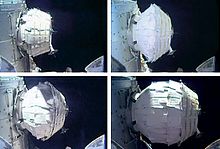Bigelow Expandable Activity Module
| Bigelow Expandable Activity Module | ||||||||||||||||||||||
|---|---|---|---|---|---|---|---|---|---|---|---|---|---|---|---|---|---|---|---|---|---|---|
 BEAM model at Bigelow Aerospace Headquarters
|
||||||||||||||||||||||
| Space station: | International space station | |||||||||||||||||||||
| Start date: | April 8, 2016 | |||||||||||||||||||||
| Launcher: | Falcon 9 v1.2 | |||||||||||||||||||||
| Coupling: | April 16, 2016 | |||||||||||||||||||||
| Dimensions: | 1360 kg | |||||||||||||||||||||
| Length: | 4 m | |||||||||||||||||||||
| Diameter: | 3.2 m | |||||||||||||||||||||
| Volume: | 16 m 3 | |||||||||||||||||||||
| Adjacent modules | ||||||||||||||||||||||
|
||||||||||||||||||||||
The Bigelow Expandable Activity Module ( BEAM ) is an inflatable space station module from Bigelow Aerospace that has been coupled to the International Space Station (ISS) on behalf of NASA since April 2016 and is expected to remain there until at least 2028 . Bigelow Aerospace planned to build a second BEAM module to serve as an airlock for the Bigelow Commercial Space Station .
Dimensions
When packed, BEAM was 2.16 m long and 2.36 m in diameter, resulting in a volume of around 3.6 m³. Since it was deployed, it has been 4.01 m long and 3.23 m in diameter. This increased the volume 4.5 times, i.e. 16 m 3 . BEAM has a mass of 1360 kg. Eight compressed air tanks and sensors are installed inside the module. Among other things, these should measure the radiation that could affect a person inside.
mission
The module was launched on April 8, 2016 at 8:43:31 p.m. ( UTC ) with the CRS-8 mission in the unpressurized part of the Dragon space freighter to the ISS, after the launch initially planned for August 2015 due to the CRS-7 crash had been postponed several times. It was transported with the gripper arm to the rear end of the Tranquility module on April 16, 2016 and docked there at 09:36 a.m. (UTC).

On May 28, 2016, after a failed attempt the day before, the module started again to inflate. The entire process took about seven hours, during which the American astronaut Jeffrey Williams opened the valves of the eight built-in air tanks for short blasts of air. In between, the module was given time to spread out in order to avoid damage. In total, Williams opened the valves 25 times for a total of 2 minutes and 27 seconds. The module reached its full size at 8:10 p.m. About ten minutes later, the pressure in the module was increased further and brought into line with that of the station.
In the following weeks the module was checked for leaks and its structural stability checked. On June 6, 2016, Jeff Williams and his Russian colleague Oleg Skripotschka entered BEAM for the first time to take air samples and collect data from sensors. For security reasons, the connection hatch to the rest of the space station remained closed for most of the time. It was only opened when the astronauts were testing the module.
BEAM was tested on the ISS for about two years, with the aim of clarifying, among other things, whether people would be adequately protected against radiation and the extreme temperature fluctuations in space as well as against space debris flying around . The original plan was to subsequently disconnect the module and let it burn up in the earth's atmosphere . After the first successful year of testing without pressure loss, however, the decision was made to leave it at the ISS at least until October 2020. In addition, brackets were installed so that the space could be used as a warehouse. In addition , NASA certified the module for possible use until 2028.
Web links
- Bigelow: The Bigelow Expandable Activity Module (BEAM )
- NASA: Bigelow Expandable Activity Module (BEAM) (English)
- BEAM infographic
Individual evidence
- ↑ BEAM Facts and Figures: Learn of the Module Launching on SpaceX Dragon. In: nasa.gov. Retrieved April 13, 2016 .
- ^ Launch Schedule. In: spaceflightnow.com. Spaceflight Now Inc., March 19, 2016, accessed March 19, 2016 .
- ↑ ISS: Astronaut inflates inflatable module for space station. In: spiegel.de. Spiegel Online , accessed May 29, 2016 .
- ↑ NASA - BEAM Expanded To Full Size. In: nasa.gov. Retrieved May 29, 2016 .
- ^ NASA - BEAM Fully Expanded and Pressurized. In: nasa.gov. Retrieved May 29, 2016 .
- ↑ Astronauts enter inflatable ISS module. In: heute.de. Second German Television , June 6, 2016, archived from the original on June 10, 2016 ; accessed on June 10, 2016 .
- ^ After A Year In Space, The Air Hasn't Gone Out Of NASA's Inflated Module. In: npr.org. Retrieved July 27, 2017 (English).
- ↑ NASA Extends Expandable Habitat's Time on the International Space Station. Press release. NASA, December 4, 2017, accessed January 8, 2019 .
- ^ Jeff Foust: NASA planning to keep BEAM module on ISS for the long haul. In: Spacenews. August 12, 2019, accessed August 12, 2019 .

